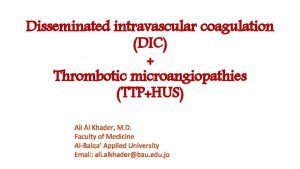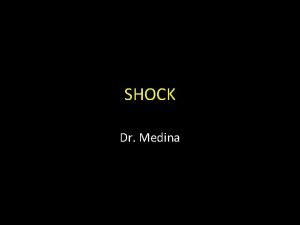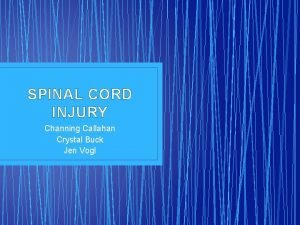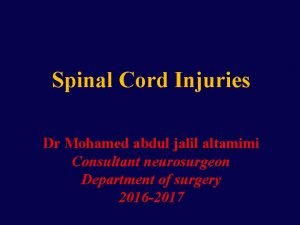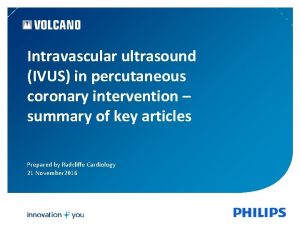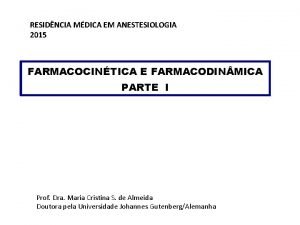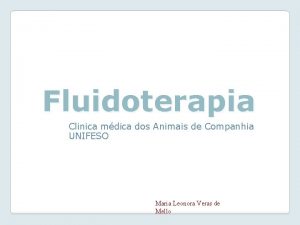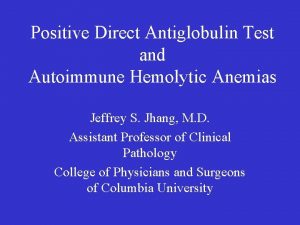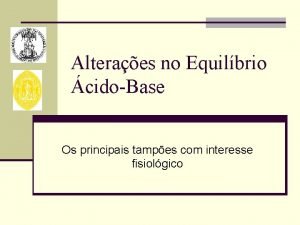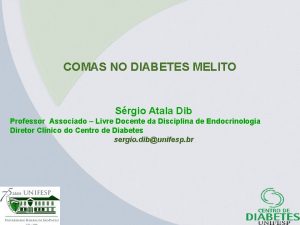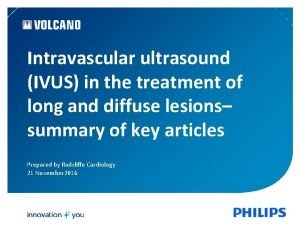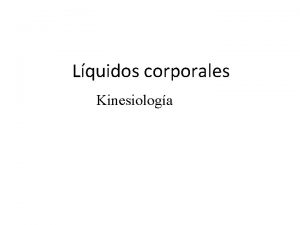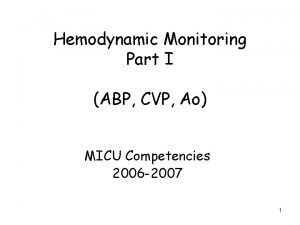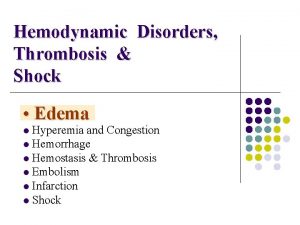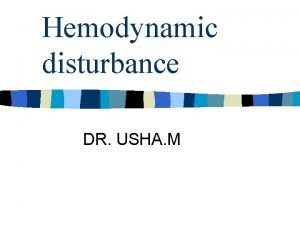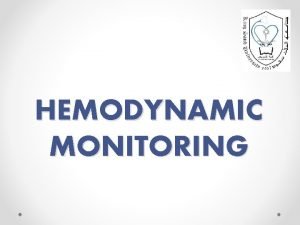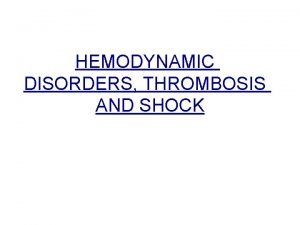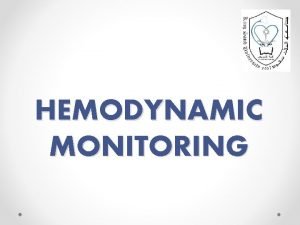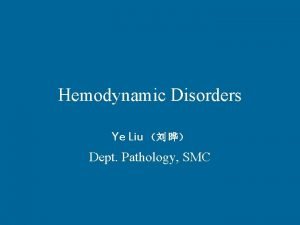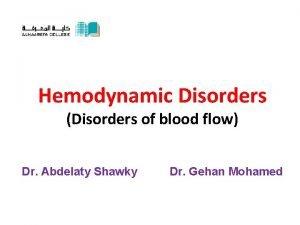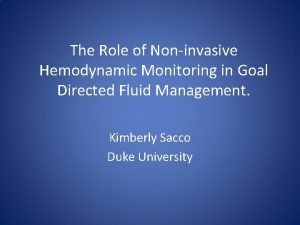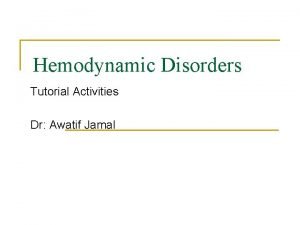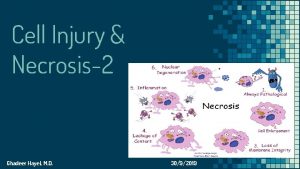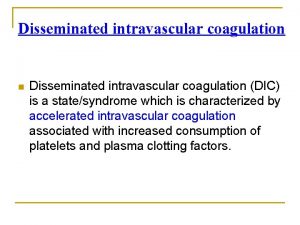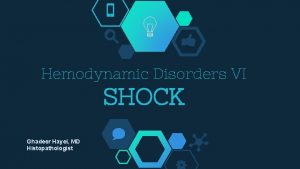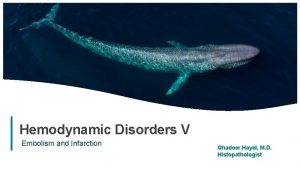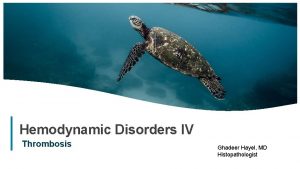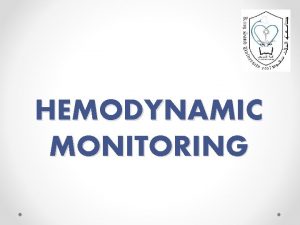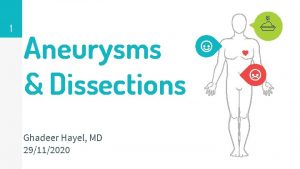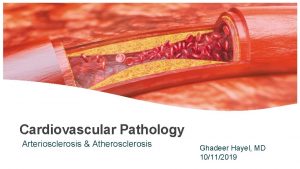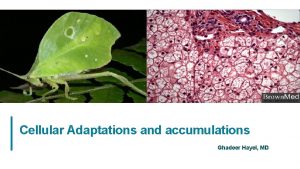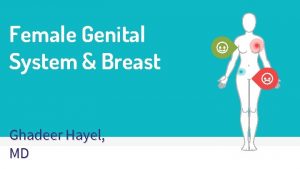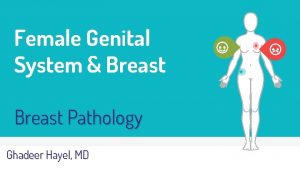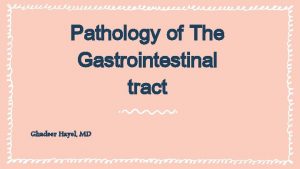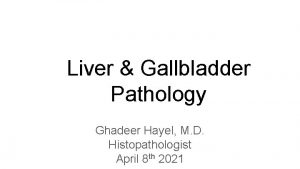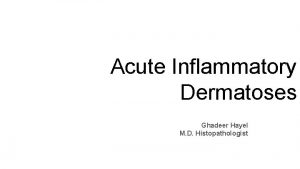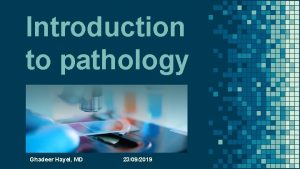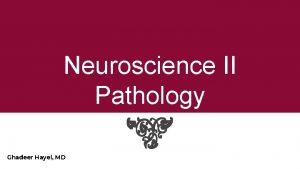Hemodynamic 6 SHOCK Ghadeer Hayel MD Disseminated Intravascular






























- Slides: 30

Hemodynamic- 6 SHOCK Ghadeer Hayel, MD

Disseminated Intravascular Coagulation (DIC) + Widespread thrombosis within microcirculation that may be of sudden (acute) or insidious onset. + Life threatening disorder (Death is coming!) + Seen as a complication in many settings starting from obstetric complications to advanced malignancy. + The widespread microvascular thrombosis consumes platelets and coagulation proteins (hence the synonym consumptive coagulopathy), also, fibrinolytic mechanisms are activated. 2 + The net result is that excessive clotting and bleeding may co-exist in the same patient

SHOCK! ◇ ◇ 3 Commonly misused “psychogenic” A state in which diminished cardiac output or reduced effective circulating blood volume impairs tissue perfusion and leads to cellular hypoxia.

4

Shock fall into three general categories: Cardiogenic shock Low cardiac output (myocardial pump failure). Caused by myocardial damage (infarction), ventricular arrhythmias, extrinsic compression (cardiac tamponade), or outflow obstruction (PE). 5 Hypovolemic shock Septic shock Low cardiac output due to loss of blood or plasma volume (hemorrhage or fluid loss from severe burns) Triggered by microbial infections. associated with severe systemic inflammatory response syndrome (SIRS).

6

◇ At the start, cellular injury is reversible, but ◇ “ 7 prolonged shock eventually leads to irreversible tissue injury and is often fatal Less commonly, shock can result from a loss of vascular tone associated with anesthesia or secondary to a spinal cord injury (neurogenic shock). Anaphylactic shock results from systemic vasodilation and increased vascular permeability that is triggered by an immunoglobulin E–mediated hypersensitivity reaction

Septic shock ◇ In US 2% of all admissions (half of the ICU) ◇ Septic shock incidence is increasing with time due to (1) Ironically, improvements in life support for critically ill patients. (2) Growing ranks of immunocompromised hosts (chemotherapy, immunosuppression, advanced age, or human immunodeficiency virus infection). (3) Increasing prevalence of multi-drug resistant organisms in the hospital setting. 8

◇ Septic shock is most frequently triggered by gram positive bacterial infections, followed by gram-negative “endotoxic shock”. ◇ Microorganisms can cause septic shock because a “ variety of microbial constituents can trigger the process. ◇ Macrophages, neutrophils, dendritic cells, endothelial cells, and soluble components of the innate immune system (e. g. , complement) recognize and are activated by several substances derived from microorganisms. ◇ These cells initiate a number of inflammatory responses that interact in a complex fashion to produce septic shock and multiorgan dysfunction. 9

Pathogenesis of Septic Shock

Inflammatory responses Microbial cell wall constituents engage receptors on cells of the innate immune system: (1) Toll-like receptors (TLRs) recognize substances containing “pathogen-associated molecular patterns” (PAMPs). (2) G-protein–coupled receptors: detect bacterial peptides. (3) C-type lectin receptors (Dectins). 11

. . Inflammatory responses ◇ ◇ ◇ 12 Activated immune cells produce numerous cytokines (TNF, IL-1, IFN-γ, IL-12, and IL-18, ), inflammatory mediators (high-mobility group box 1 protein (HMGB 1)). These molecules induce endothelial and other cells to upregulate adhesion molecule expression and further stimulate cytokine and chemokine production. The complement cascade is also activated by microbial components; anaphylotoxins (C 3 a, C 5 a), chemotactic fragments (C 5 a), and opsonins (C 3 b).

Counterinflammatory responses. ◇ ◇ ◇ 13 Hyperinflammatory state triggers counterregulatory immunosuppressive mechanisms. Patients may oscillate between hyperinflammatory and immunosuppressed states during their clinical course. Counterregulatory mechanisms can result to immune suppression renders patients susceptible to superinfections.

. . Counterinflammatory responses. (1) a shift from proinflammatory (TH 1) to antiinflammatory (TH 2) cytokines. (2) anti-inflammatory mediators (soluble TNF receptor, IL-1 receptor antagonist, and IL-10) (3) lymphocyte apoptosis. (4) Induction of cellular anergy (Lack of reaction). 14

Endothelial activation and injury ◇ ◇ ◇ 15 Inflammatory cytokines loosen endothelial cells tight junctions vessels leak accumulation of proteinrich fluid throughout the body. This impedes tissue perfusion hinders nutrient delivery and waste removal (this is exacerbated by Tx with intravenous fluids). Activated endothelium upregulates production of nitric oxide (NO) vasoactive mediators (C 3 a, C 5 a, and PAF), contribute to vascular smooth muscle relaxation systemic hypotension.

Induction of a procoagulant state ◇ ◇ ◇ 16 Alters the expression of factors to favor coagulation. Proinflammatory cytokines increase tissue factor production and decrease the production of endothelial anti-coagulant factors. Dampen fibrinolysis (increasing plasminogen activator inhibitor-1) Vascular leak and edema decrease blood flow stasis diminished washout of activated coagulation factors. Produce DIC in up to half of septic patients.

Metabolic abnormalities ◇ ◇ ◇ 17 Hyperglycemia; cytokines (TNF & IL-1) stress-induced hormones (glucagon, growth hormone, and glucocorticoids), and catecholamines all drive gluconeogenesis. Insulin resistance; proinflammatory cytokines suppress insulin release & promot insulin resistance liver and other tissues, impairing expression of GLUT-4, a glucose transporter. Hyperglycemia decreases neutrophil bactericidal function and increased adhesion molecule on endothelial cells.

Metabolic abnormalities In sepsis, initially, an acute surge in glucocorticoid production happened, but it maybe followed by adrenal insufficiency: (1) A functional deficit of glucocorticoids (depression of the synthetic capacity) (2) Adrenal necrosis from DIC (Waterhouse. Friderichsen syndrome) ◇ Cellular hypoxia diminished oxidative phosphorylation increased lactate production and lactic acidosis (anaerobic glycolysis) ◇ 18

Organ dysfunction ◇ ◇ ◇ 19 Systemic hypotension, interstitial edema, and small vessel thrombosis all decrease the delivery of oxygen and nutrients cellular hypoxia. Mitochondrial damage from oxidative stress impairs oxygen use. Cytokines and secondary mediators diminish myocardial contractility and cardiac output. Vascular permeability and endothelial injury can lead to the acute respiratory distress syndrome All these factors cause multiple organs failure (kidneys, liver, lungs, and heart) Death.

Severity and outcome of septic shock depends on: ◇ ◇ The extent and virulence of the infection, The immune status of the host, The presence of other comorbid conditions, Pattern and level of mediator production. The multiplicity of factors and their complexity explain why attempts to intervene therapeutically with antagonists of specific mediators have not been effective and may had harmful effects in some cases. 20

Management q Intravenous fluids, vasopressors, and supplemental oxygen to maintain blood pressure and limit tissue hypoxia. q even in the best of clinical centers, septic shock remains an obstinate clinical challenge. 21

Stages of shock ◇ ◇ 22 Shock is a progressive disorder that leads to death if the underlying problems are not corrected. Unless the insult is massive and rapidly, shock tends to evolve through three general stages. (documented most clearly in hypovolemic shock but are common to other forms as well)

An initial nonprogressive stage. Reflex compensatory mechanisms are activated and vital organ perfusion is maintained. 23 A progressive stage. Tissue hypoperfusion & onset of worsening circulatory & metabolic derangement, including acidosis. An irreversible stage. Cellular and tissue injury is so severe that even if the hemodynamic defects are corrected, survival is not possible.

Neurohumoral mechanisms maintain cardiac output and blood pressure: ◇ Baroreceptor reflexes ◇ Release of catecholamines ◇ Anti-diuretic hormone. ◇ Activation of the renin-angiotensin-aldersterone axis. ◇ Generalized sympathetic stimulation. Net effect : tachycardia, peripheral vasoconstriction, and renal fluid conservation. Coronary and cerebral vessels are less sensitive to sympathetic signals maintain relatively normal caliber, blood flow, and oxygen delivery. Thus, blood is shunted away from the skin to the vital organs such as the heart and the brain. 24

§ Prognosis varies with the origin of shock and its duration. § More than 90% of young, otherwise healthy patients with hypovolemic shock survive with appropriate management. § septic & cardiogenic shock are associated with worse outcomes, even with state-of-theart care. 25

Cutaneous vasoconstriction causes the characteristic “shocky” skin coolness and pallor. Septic shock can initially cause cutaneous vasodilation, so the patient may present with warm, flushed skin. 26

Morphology 27

◇ ◇ ◇ 28 The cellular and tissue effects of shock are essentially those of hypoxic injury (combination of hypoperfusion and microvascular thrombosis) Any organ can be affected, the brain, heart, kidneys, adrenals, and gastrointestinal tract are most commonly involved. Fibrin thrombi can form in any tissue but typically are most readily visualized in kidney glomeruli.

◇ ◇ ◇ 29 Adrenal cortical cell lipid depletion reflects increased use of stored lipids for steroid synthesis. lungs are resistant to hypoxic injury in hypovolemic shock occurring after hemorrhage, sepsis or trauma can precipitate diffuse alveolar damage Except for neuronal and cardiomyocyte loss, affected tissues can recover completely if the patient survives.

Thanks! Any questions? 30
 Disseminated intravascular coagulation pathophysiology
Disseminated intravascular coagulation pathophysiology Hus dic
Hus dic Ghadeer khum
Ghadeer khum Two node loop instability
Two node loop instability Shock normovolemico
Shock normovolemico Spinal shock vs neurogenic shock
Spinal shock vs neurogenic shock T10 spinal cord
T10 spinal cord Site:slidetodoc.com
Site:slidetodoc.com Subacute combined degeneration of the cord
Subacute combined degeneration of the cord Ivus
Ivus Liquido intersticial y liquido intravascular
Liquido intersticial y liquido intravascular Farmacodin
Farmacodin Liquido intravascular
Liquido intravascular Intravascular hemolytic anemia
Intravascular hemolytic anemia Curva de titulação da glicina
Curva de titulação da glicina Sergio atala dib
Sergio atala dib Ivus
Ivus Espacio extracelular e intracelular
Espacio extracelular e intracelular Hemodynamic disorders
Hemodynamic disorders Hemodynamic monitoring system
Hemodynamic monitoring system Hemodynamic disorders
Hemodynamic disorders Normal hemodynamic values
Normal hemodynamic values Edema lesion
Edema lesion Company logo
Company logo Body fluid
Body fluid Moniter definition
Moniter definition Hemodynamic disorders
Hemodynamic disorders Difference between hyperemia and congestion
Difference between hyperemia and congestion Pinsky hemodynamic monitoring
Pinsky hemodynamic monitoring Hemodynamic disorders
Hemodynamic disorders King george cousins family tree
King george cousins family tree

